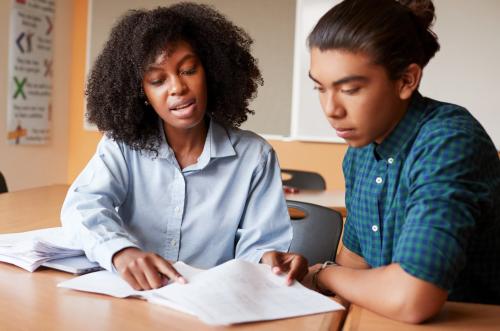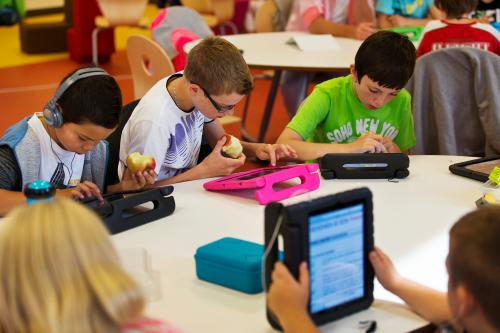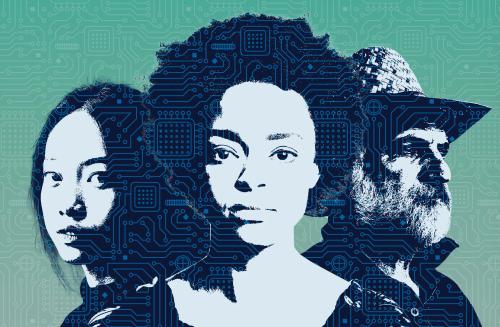In March 2020, virtually all public school districts in the U.S. shut their doors. For the next 18 months, schooling looked like it never had before. Homes became makeshift classrooms; parents became de facto teachers. But by fall 2022, many aspects of K-12 education had returned to “normal.” Schools resumed in-person classes, extracurricular activities flourished, and mask mandates faded.
But did schools really return to what they were before the COVID-19 pandemic? Our research suggests not. We interviewed teachers, school leaders, and district administrators across 12 districts in two states, and then we surveyed a nationally representative set of veteran educators in May 2023. We found that the COVID-19 pandemic transformed K-12 education in fundamental ways.
Below, we describe how the pandemic reshaped the educational landscape in these ways and we consider the opportunities and challenges these changes present for students, educators, and policymakers.
Accelerated adoption of technology
One of the most immediate and visible changes brought about by the pandemic was the rapid integration of technology into the classroom. Before COVID-19, many schools were easing into the digital age. The switch to remote learning in March 2020 forced schools to fully embrace Learning Management Systems (LMS), Zoom, and educational software almost overnight.
When students returned to in-person classrooms, the reliance on these digital tools persisted. Over 70% of teachers in our survey report that students are now assigned their own personal device (over 80% for secondary schools). LMS platforms like Google Classroom and Schoology remain essential in many schools. An assistant superintendent of a middle-income district remarked, “Google Classroom has become a mainstay for many teachers, especially middle school [and] high school.”
The platforms serve as hubs for posting assignments, accessing educational content, and enabling communication between teachers, students, and parents. They have become popular among parents as well. One teacher, who has school-age children herself, noted:
“Whereas pre-COVID…you’re hoping and praying your kids bring home information…[now] I can go on Google classroom and be like, ‘Oh, it says you worked on Mesopotamia today. What was that lesson about?’”
Transformed instructional practices
The pandemic’s impact on student learning was profound. Reading and math scores dropped precipitously, and the gap widened between more and less advantaged students. Many schools responded by adjusting their schedules or adopting new programs. Several mentioned adopting “What I need” (WIN) or “Power” blocks to accommodate diverse learning needs. During these blocks, teachers provide individualized support to students while others work on independent practice or extension activities.
Teachers report placing greater emphasis on small-group instruction and personalized learning. They spend less time on whole-class lecture and rely more on educational software (e.g., Lexia for reading and Zearn for math) to tailor instruction to individual student needs. A third-grade teacher in a low-income district explained:
“The kids are in so many different places, Lexia is very prescriptive and diagnostic, so it will give the kids specifically what level and what skills they need. [I] have a student who’s working on Greek and Latin roots, and then I have another kid who’s working on short vowel sounds. [It’s] much easier for them to get it through Lexia than me trying to get, you know, 18 different reading lessons.”
Teachers aren’t just using technology to personalize instruction. Having spent months gaining expertise with educational software, more teachers find it natural to integrate those programs into their classrooms today. Those teachers who used ed tech before report doing so even more now. They describe using software like Flowcabulary and Prodigy to make learning more engaging, and games such as Kahoot to give students practice with various skills. Products like Nearpod let them create presentations that integrate instruction with formative assessment. Other products, like Edpuzzle, help teachers monitor student progress.
Some teachers discovered how to use digital tools to save time and improve their communications to students. One elementary teacher, for example, explains even when her students complete an assignment by hand, she has them take a picture of it and upload it to her LMS:
“I can sort them, and I can comment on them really fast. So it’s made feedback better. [I have] essentially a portfolio of all their math, rather than like a hard copy that they could lose…We can give verbal feedback. I could just hit the mic and say, ‘Hey, double check number 6, your fraction is in fifths, it needs to be in tenths.’”
Increased emphasis on social-emotional learning
The pandemic also revealed and exacerbated the social-emotional challenges that students face. In our survey, nearly 40% of teachers report many more students struggling with depression and anxiety than before the COVID-19 pandemic; over 80% report having at least a few more students struggling.
These student challenges have changed teachers’ work. When comparing how they spend class time now versus before the pandemic, most teachers report spending more time on activities relating to students’ social-emotional well-being (73%), more time addressing behavioral issues (70%), and more time getting students caught up and reviewing routines and procedures (60%).
In response, schools have invested in social-emotional learning (SEL) programs and hired additional counselors and social workers. Some districts turned to online platforms such as Class Catalyst and CloseGap that allow students to anonymously report their emotional state on a daily basis, which helps school staff track students’ mental health.
Teachers also have been adapting their expectations of students. Many report assigning less homework and providing students more flexibility to turn in assignments late and retake exams.
Facilitated virtual communication between parents and teachers
The pandemic also radically reshaped parent-teacher communications. Mirroring trends across society, videoconferencing has become a go-to option. Schools use videoconferencing for regular parent-teacher conferences, along with meetings to discuss special education placements and disciplinary incidents. In our national survey, roughly one-half of teachers indicate that they conduct a substantial fraction of parent-teacher conferences online; nearly a quarter of teachers report that most of their interactions with parents are virtual.
In our interviews, teachers and parents gushed about the convenience afforded by videoconferencing, and some administrators believe it has increased overall parent participation. (One administrator observed, “Our attendance rates [at parent-teacher conferences] and interaction with parents went through the roof.”)
An administrator from a low-income district shared the benefits of virtual Individualized Education Plan (IEP) meetings:
“It’s rare that we have a face-to-face meeting…everything is Docusigned now. Parents love it because I can have a parent that’s working—a single mom that’s working full time—that can step out during her lunch break…[and] still interact with everybody.”
During the pandemic, many districts purchased a technology called Remind that allows teachers to use their personal smartphones to text with parents while blocking their actual phone number. We heard that teachers continue to text with parents, citing the benefits for quick check-ins or questions. Remind and many LMS also have translation capabilities that makes it easier for teachers and parents to overcome language barriers.
Moving forward
The changes described above have the potential to improve student learning and increase educational equity. They also carry risks. On the one hand, the growing use of digital tools to differentiate instruction may close achievement gaps, and the ubiquity of video conferencing could allow working parents to better engage with school staff. On the other hand, the overreliance on digital tools could harm students’ fine motor skills (one teacher remarked, “[T]heir handwriting sucks compared to how it used to be”) and undermine student engagement. Some new research suggests that relying on digital platforms might impede learning relative to the old-fashioned “paper and pencil” approach. And regarding virtual conferences, the superintendent of a small, rural district told us, “There’s a disconnect when we do that…No, I want the parents back in our buildings, I want people back. We’re [the school] a community center.”
Of course, some of the changes we observed may not persist. For example, fewer teachers may rely on digital tools to tailor instruction once the “COVID cohorts” have aged out of the system. As the emotional scars of the pandemic fade, schools may choose to devote fewer resources to SEL programming. It’s important to note, too, that many of the changes we found come from the adoption of new technology, and the technology available to educators will continue to evolve (e.g., with the integration of new AI technologies into personalized tutoring systems). That being said, now that educators have access to more instructional technology and—perhaps more importantly—greater familiarity with using such tools, they might continue to rely on them.
The changes brought about by the COVID-19 pandemic provide a unique opportunity to rethink and improve the structure of K-12 education. While the integration of technology and the focus on social-emotional learning offer promising avenues for enhancing student outcomes, they also require continuous evaluation. Indeed, these changes raise some questions beyond simple cost-benefit calculations. For example, the heightened role of ed tech raises questions about the proper role of the private sector in public education. As teachers increasingly “outsource” the job of instruction to software products, what might be lost?
Educational leaders and policymakers must ensure that these pandemic-inspired changes positively impact learning and address the evolving needs of students and teachers. As we navigate this new educational landscape, the lessons learned from this unprecedented time can serve as a guide for building a more resilient, equitable, and effective educational system for the future.
Beyond technological changes, COVID-19 shifted perspectives about K-12 schooling. A middle-school principal described a new mentality among teachers in her district, “I think we have all become more readily able to adapt…we’ve all learned to assess what we have in front of us and make the adjustments we need to ensure that students are successful.” And a district administrator emphasized how the pandemic highlighted the vital role played by schools:
“…we saw that when students were not in school. From a micro and macro level, the environment that a school creates to support you growing up…we realized how needed this network is…both academically and socially, in growing our citizens up to be productive in the world. And we are happy to have everyone back.”
At the end of the day, this realization may be one of the pandemic’s most enduring legacies.





